
The true owls or typical owls are one of the two generally accepted families of owls, the other being the barn owls (Tytonidae). This large family comprises 230 living or recently extinct species in 24 genera. The typical owls have a cosmopolitan distribution and are found on every continent except Antarctica.

Barn-owls are one of the two families of owls, the other being the true owls or typical owls, Strigidae. They are medium to large owls with large heads and characteristic heart-shaped faces. They have long, strong legs with powerful talons. They also differ from the Strigidae in structural details relating in particular to the sternum and feet.

The American horned owls and the Old World eagle-owls make up the genus Bubo, at least as traditionally described. The genus name Bubo is Latin for owl.
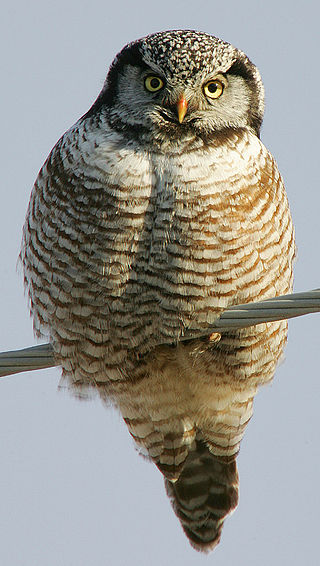
The northern hawk-owl or northern hawk owl is a medium-sized true owl of the northern latitudes. It is non-migratory and usually stays within its breeding range, though it sometimes irrupts southward. It is one of the few owls that is neither nocturnal nor crepuscular, being active only during the day. This is the only living species in the genus Surnia of the family Strigidae, the "typical" owls. The species is sometimes called simply the hawk owl; however, many species of owls in the genus Ninox are also called "hawk owls".

The flammulated owl is a small migratory North American owl in the family Strigidae. It is the only species placed in the genus Psiloscops.

The elf owl is a small grayish-brown owl about the size of a sparrow found in the Southwestern United States, central Mexico, and the Baja California peninsula. It has pale yellow eyes highlighted by thin white "eyebrows" and a gray bill with a horn-colored tip. The elf owl frequently inhabits woodpecker holes in saguaro cacti; it also nests in natural tree cavities. It is nocturnal and feeds primarily on insects.

Pygmy owls are members of the genus Glaucidium. They belong to the typical owl family, Strigidae. The genus consists of 29 species distributed worldwide. These are mostly small owls, and some of the species are called "owlets". Most pygmy owl species are diurnal, meaning they are most active during dawn, dusk, and daytime, and they mainly hunt large insects and other small prey. While primarily prevalent in North American countries—including the United States, Canada, and Mexico—Pygmy owls are considered threatened subspecies under the United States Endangered Species Act. More specifically, these owls can be found lurking in the mountain ranges of western United States territory, including California.
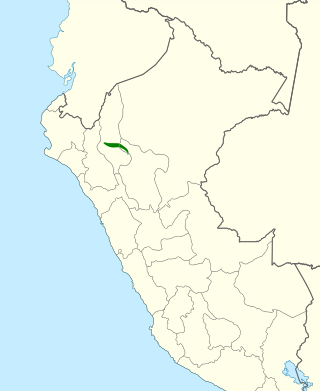
The long-whiskered owlet is a tiny owl that is endemic to a small area in the Andean mountains in Amazonas and San Martín in northern Peru. It is restricted to cloud forests with dense undergrowth and epiphytes at about 1,890–2,200 m (6,200–7,220 ft) asl.

Strix is a genus of owls in the typical owl family (Strigidae), one of the two generally accepted living families of owls, with the other being the barn-owl (Tytonidae). Common names are earless owls or wood owls, though they are not the only owls without ear tufts, and "wood owl" is also used as a more generic name for forest-dwelling owls. Neotropical birds in the genus Ciccaba are sometimes included in Strix.

The Puerto Rican owl or múcaro común, formerly known as the Puerto Rican screech owl, is a mid-sized "typical owl" in subfamily Striginae. It is endemic to the archipelago of Puerto Rico though it formerly also inhabited the Virgin Islands.

The striped owl is a medium-sized owl with large ear tufts and a brownish-white facial disk rimmed with black. Its beak is black, and it has cinnamon-colored eyes. It has shorter, rounder wings than most of its close relatives. The upperparts are cinnamon with fine black vermiculation and heavy stripes. The underparts are pale tawny with dusky streaks. It is native to South America and parts of Central America.

The Jamaican owl is a medium-sized owl that is endemic to the island of Jamaica.
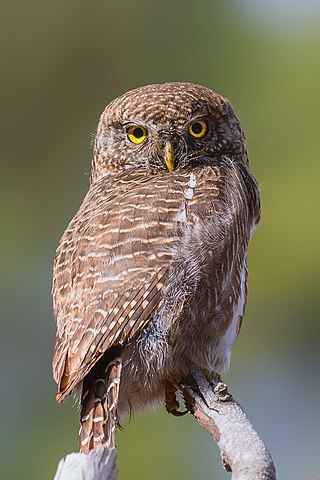
The Asian barred owlet also known as the Cuckoo owlet is a species of pygmy owl native to the forests and shrublands of mainland Southeast Asia to the foothills of the Himalayas of northern Pakistan. It is a smaller owl, measuring 22–25 cm (8.7–9.8 in) making it one of the larger pygmy owls. They are primarily insectivorous but will eat lizards, small rodents and birds as well.

Ketupa is a genus of owls in the family Strigidae. The genus formerly contained just three species, the fish owls but based on the results from a genetic study published in 2020, the generic boundaries were altered. The genus now contains twelve species, nine of which were formerly placed in the genus Bubo.
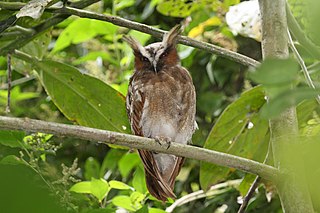
The crested owl is a species of owl in the family Strigidae. It is the only species (monotypic) in the genus Lophostrix. It is a resident bird and occurs in Central America and northern South America. It is a medium-sized owl, easily recognizable with its very long whitish ear tufts and otherwise darker appearance. It inhabits lowland rainforests and prefers old growth in proximity with water. The crested owl is a strictly nocturnal species, but very little is known about its behaviour.
The Palau scops owl or Palau owl is a species of owl in the family Strigidae. Palau scops owls are dark reddish-brown with small white dots scattered across their feathers. They are endemic to the Palau Islands in the western Pacific, where they are found in woodland and lagoon trees, ravines and mangrove swamps. Palau owls nest in hollows of trees, live in groups and are territorial.
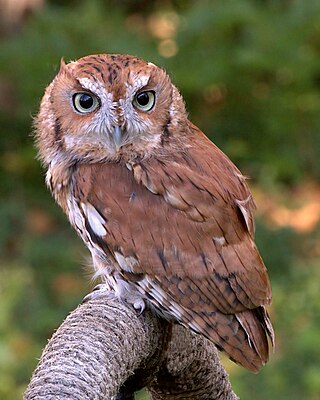
Screech owls are typical owls (Strigidae) belonging to the genus Megascops with 23 living species. For most of the 20th century, this genus was merged with the Old World scops owls in Otus, but nowadays it is again considered separately based on a range of behavioral, biogeographical, morphological, and DNA sequence data.
George Hines Lowery Jr. was an American ornithologist and professor of zoology at Louisiana State University, who pioneered a technique for studying nocturnal bird migration by large-scale observation through telescopes across the United States of America of flocks of birds as they flew at night in front of the face of the moon.

Taenioptynx is a genus of typical owls, or true owls, in the family Strigidae, that inhabits Asia.

Surniinae is a subfamily of the typical owls (Strigidae). First described by French ornithologist Charles Lucien Bonaparte in 1838. The type genus is Surnia. Includes ten genera.


















